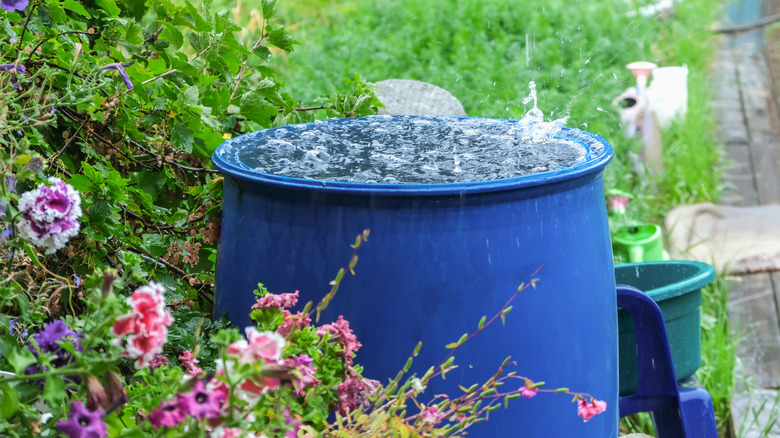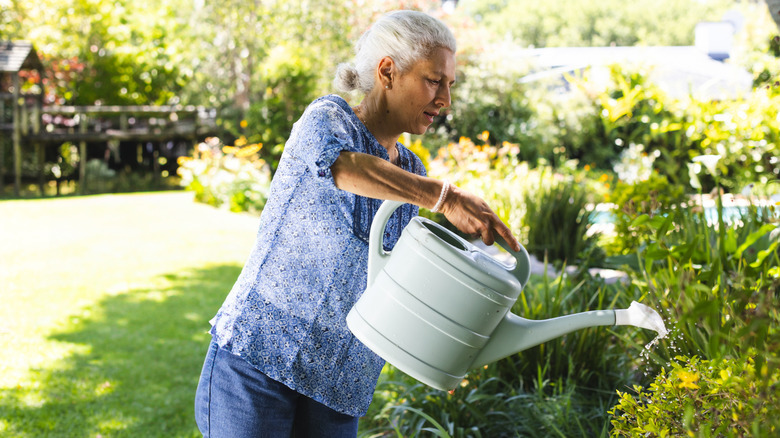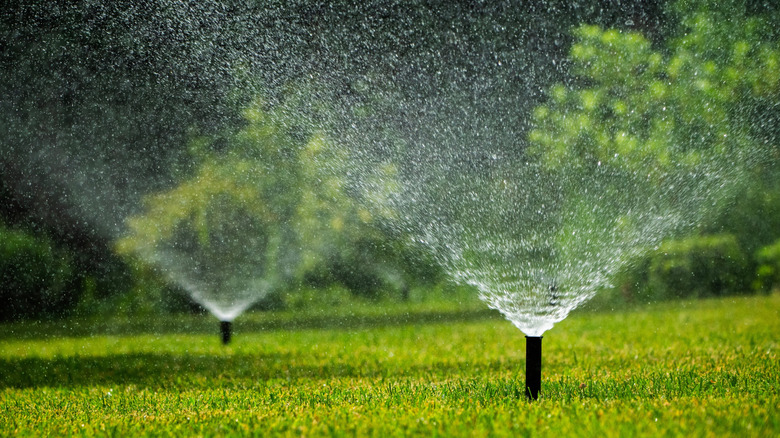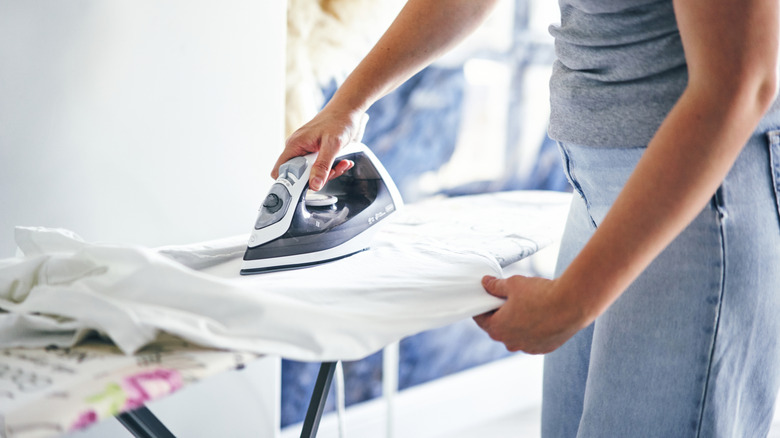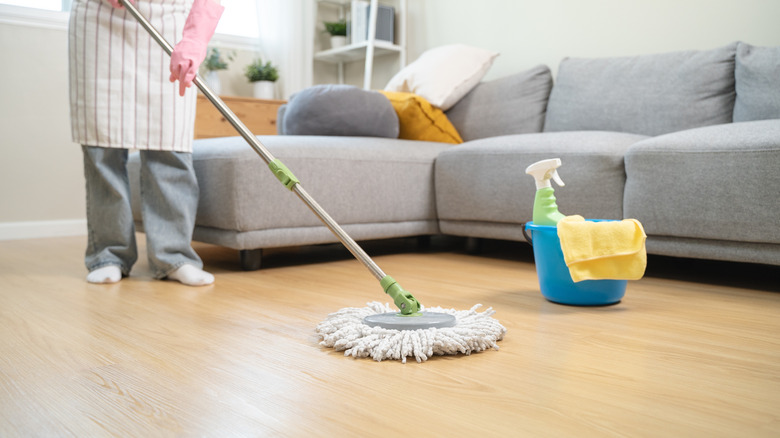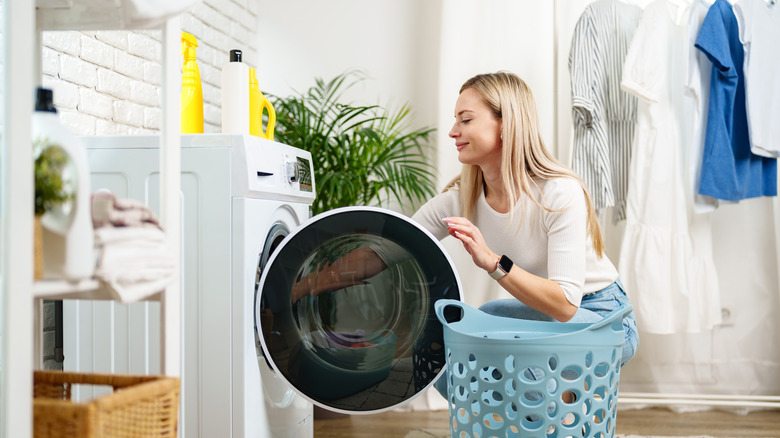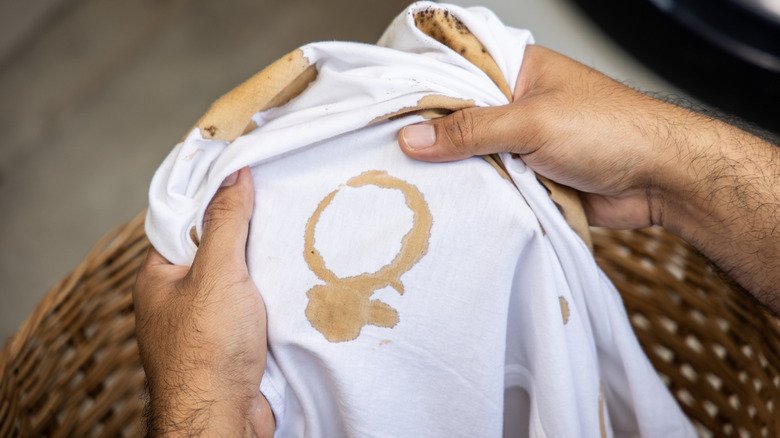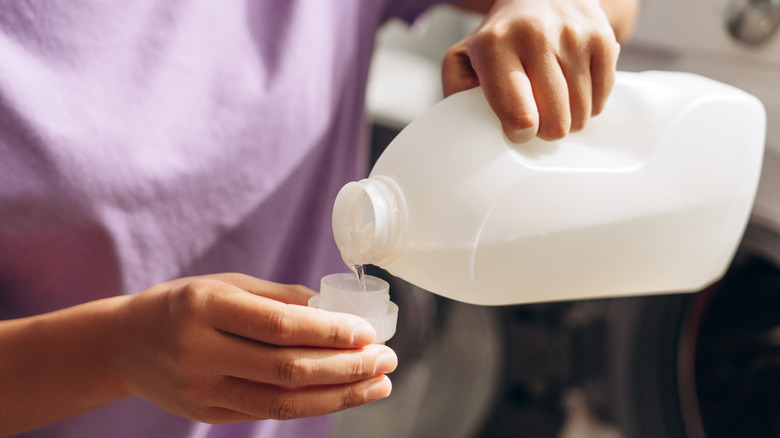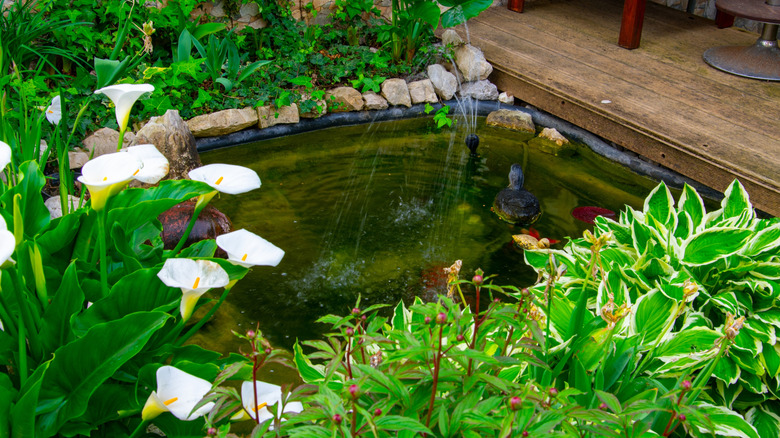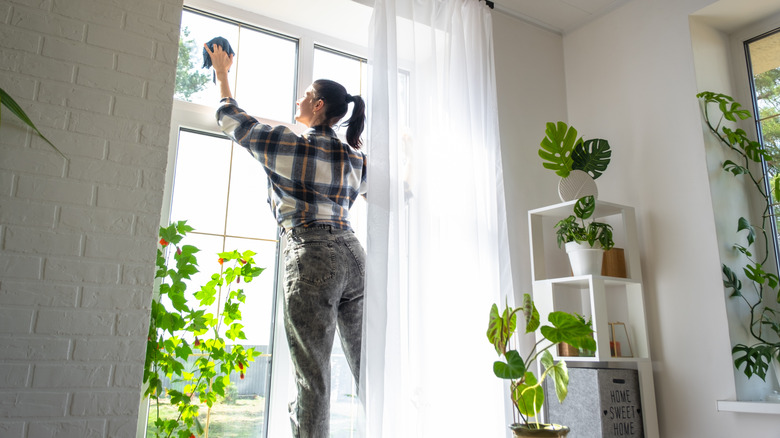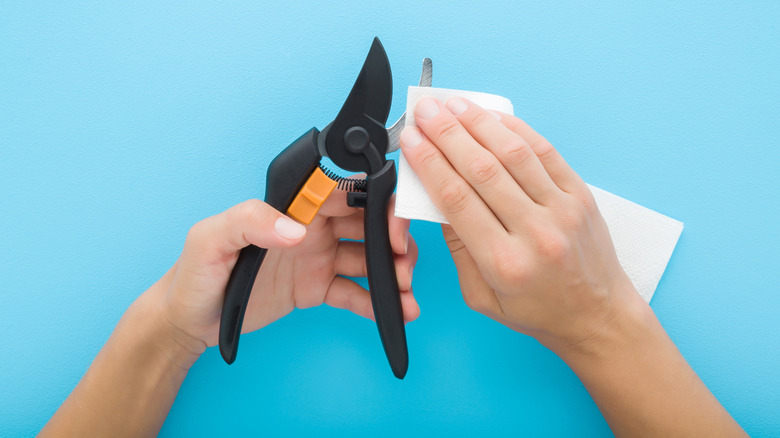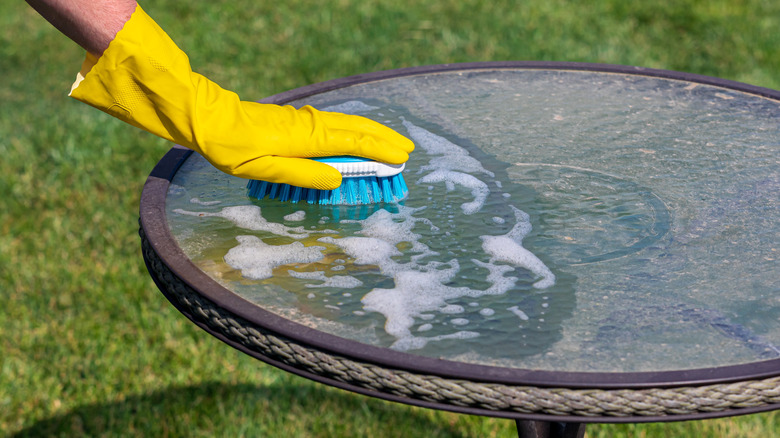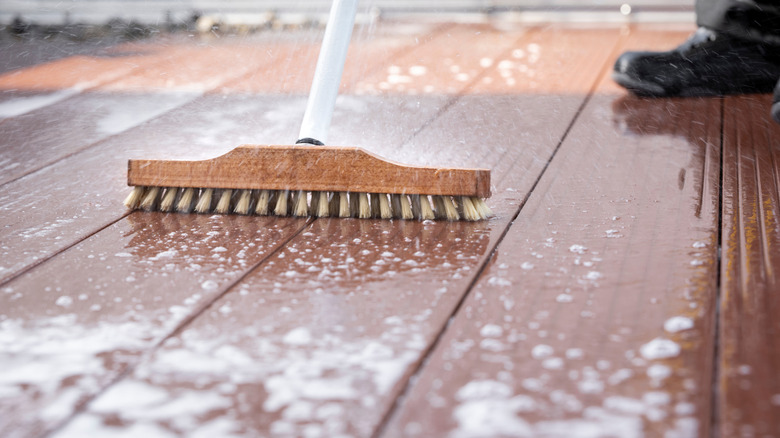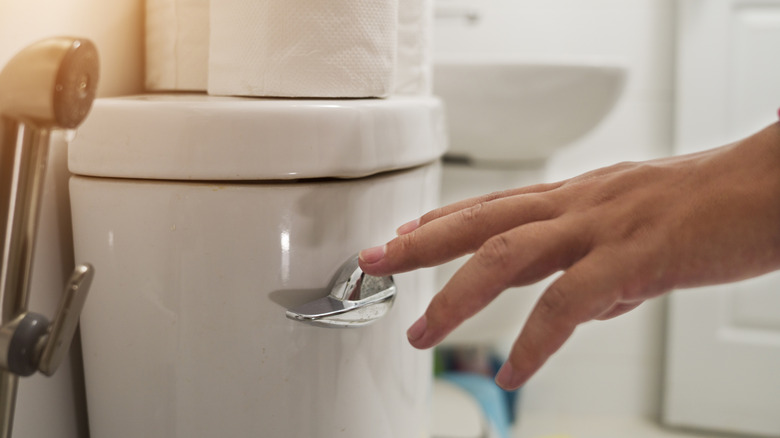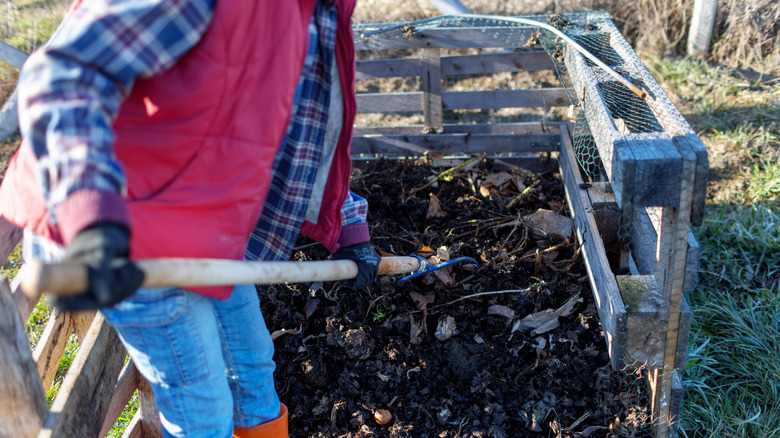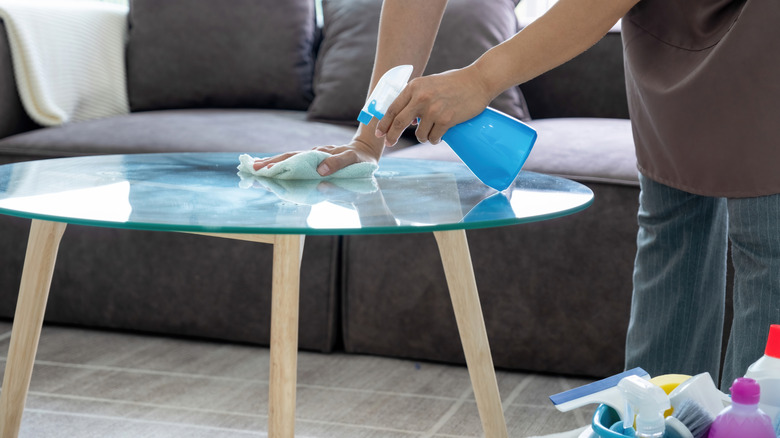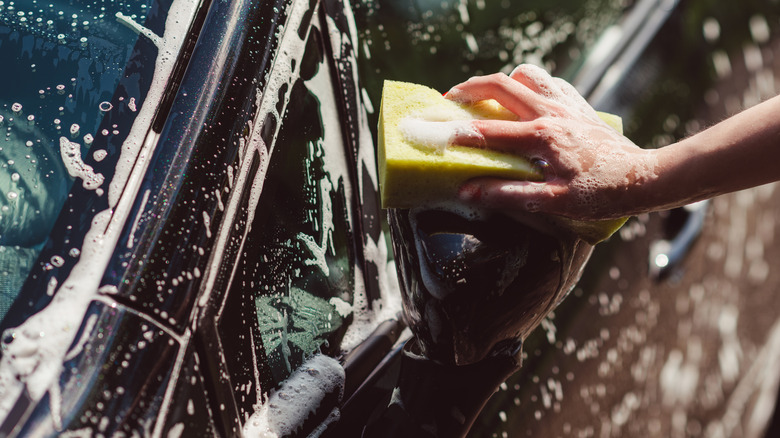16 Ways To Reuse Rainwater, Air Conditioner, Or Dehumidifier Water At Home Or In The Garden
It's often easy to use an excess of water in your home without realizing it and end up with sizable utility bills. In the United States, the average family uses over 300 gallons of water at home every day, according to the Environmental Protection Agency. While some tasks require potable water, repurposing water from your air conditioners, dehumidifiers, or even rainwater for certain cleaning and gardening chores is a great way to cut costs and practice sustainability. To give you some inspiration, we created a list of the ways you can put this water to good use in your garden and home to both lower your water bill and have a more eco-friendly household.
Keep in mind that rainwater, as well as dehumidifier and air conditioner water, is not potable. Because they come in contact with various surfaces, this water could pick up bacteria and other harmful substances, making it unsafe to drink without treatment. Because of this, you shouldn't use your stored water to wash food surfaces, though it's great for many other household and cleaning jobs. Before you start installing barrels to harvest rainwater outside, check your local regulations to ensure your methods are safe and legal where you live.
Give your houseplants and flower garden a refreshing drink
Watering your plants with harvested water is a fantastic way to practice sustainability and conserve potable water. Rainwater, air conditioner water, and dehumidifier water are softer than tap water, don't contain many minerals, and won't be loaded with chemicals or salt like water from your faucet. While plants need minerals to thrive, watering with repurposed fluid is still safe and beneficial for your plants. However, you may need to add liquid fertilizer to your stored water or combine it with a little tap water for added minerals. If you only give your plants a drink using stored water occasionally, this probably won't be necessary.
Since these types of water aren't potable and have the potential to be contaminated, they should only be used to water flowers, ornamentals, houseplants, and other plants that aren't edible. This ensures that your herbs, vegetables, and fruits don't come into contact with harmful bacteria. Additionally, if any of your houseplants are experiencing fungal issues, your dehumidifier water should not be used on other plants, as you may unintentionally spread spores.
Irrigate your lawn for greener grass at no extra cost
Utilizing stored water to water a lawn is an easy way to save money while keeping your grass healthy and green. Just as air conditioner and dehumidifier water can be repurposed to give your plants a drink, you can use it to irrigate your grass for free. Rainwater can also be very beneficial for your lawn, and redirecting it can cut down on your water expenditures.
Similarly to watering other plants, you may need to provide your grass with nutrients due to the softness of the water. Once you've gathered your water from a dehumidifier, an air conditioner, or your rainwater collection system, pour it over your grass to give your lawn a thorough drink. Alternatively, you might consider hooking up a rain barrel to your existing irrigation system to let your sprinklers do the job for you. Though it will cost more time and money, rainwater barrels can also be used to set up a new irrigation system.
Refill your iron or steamer for wrinkle-free clothes
Are you sick of spending money on distilled water for your iron or clothes steamer? Don't let your AC water go to waste; fill it with water from your AC unit or dehumidifier instead. Switching from tap water to dehumidifier or air conditioner water will prevent that pesky hard water limescale from forming. Because water from your AC unit or dehumidifier lacks minerals, it won't cause a buildup in your iron.
For this trick, simply gather and save water from your dehumidifier and AC units. When it's time to dewrinkle your clothes, fill your iron with your collected water and start steaming. Before using dehumidifier water, ensure that your iron is designed to handle distilled water. By conserving your used water for steaming and ironing, you'll do your part to help the planet, and your clothes won't know the difference.
Mop your floors with it for a streak-free finish
Another clever way to reuse rainwater around your home is to clean your floors with it. Though harvested water is not the best choice for kitchen counters because they touch food, it can be used for other surfaces, like your floors.Dehumidifier water and air conditioner water can also be used to mop floors. It doesn't leave behind streaks or marks because it's so soft. Your floors will be perfectly polished, and you'll have saved water in the process.
If you're concerned about cleaning with non-potable water, adding an antibacterial cleanser to your stored water before mopping will help eliminate any contaminants that may be in the water. Natural options like vinegar and lemon juice have some mild disinfectant properties and can get your floors squeaky clean when used with rainwater or other harvested water. Before mopping, ensure the solution you're cleaning with is safe for your specific floors.
Clean your clothes while saving money on laundry
In the United States, laundry alone takes up approximately 17% of a household's water usage, according to the city of Portland's Water Efficiency Program. Getting your clothes clean may require a lot of water, but substituting rainwater, dehumidifier water, or air conditioner water for doing laundry can make a big impact. Not only will this reduce the amount of treated water you use, but it could also make a difference for your clothing. Since the water is so much softer than tap water, they may leave your clothes feeling nicer.
The softness of the water may also allow you to use less detergent, leading to fewer or shorter rinse cycles. Now, you can keep your clothes feeling soft while saving money on water and detergent. To use your gathered water in your washing machine, you might simply pour buckets of it into your washer until you have enough for a load. For those with a basement washing machine who want a more permanent solution, an outdoor rainwater reserve can be connected by hose to your washer. The gravity will help move the water downward to fill your machine and get your clothes fresh.
Soak or treat fabrics with repurposed water to pull out stains
Since harvested water is safe for washing clothes, you can also use it to treat stains on your fabrics. In addition to doing your laundry with rainwater, dehumidifier water, or water from your AC, try further repurposing the water for soaking items with really stubborn stains, or use it to spot-treat smaller stains. This could also be a good option for those who would like to use harvested water for laundry purposes, but who aren't able to carry buckets of it to the washer. Though it's not as much water as a whole load of laundry, you'll still be saving potable water while also eliminating those pesky stains.
When spot treating your clothes, you can apply a very small amount of dish soap to the stain and lightly rub it into the fabric. Make sure that the dish soap is safe for your fabric before applying it. After allowing it to sit for several minutes, use your stored water to wash away the soap and lift the stain before further laundering. Alternatively, you might make a solution with your collected water and white vinegar to give your clothing a stain-busting soak.
Make your own liquid laundry detergent
If you prefer more natural soaps and cleansers, try using your air conditioning water to craft your own liquid laundry detergent. Dehumidifier water and rainwater should also work well for this trick, as they are safe for washing your clothes. It would be easy to substitute the water you already use for this gray water alternative. You can make your own liquid laundry soap with just a few ingredients, cutting down on water and detergent use at the same time.
To make your detergent, you'll need washing soda, Castile soap, Borax, and harvested water. Essential oils can also be added to give your laundry a fresh scent. You can also grate a bar of soap instead of using liquid Castile soap. Combine 1 cup of each of Borax and washing soda into 6 cups of boiling, harvested water. Once it's dissolved, add in a cup of soap and 9 more cups of water. After it's cooled a little, drop in some essential oils if you'd like.
Transform your outdoor space with stunning water fixtures
Ponds, fountains, waterfalls, and other water features can make your backyard feel luxurious, and it's easy to sustain them with harvested water. When water levels become low, top off your fountain or pond with your air conditioning water or rainwater. Dehumidifier water should also work well, as it has similar properties to water from AC units. Alternatively, you could use this water to create a new fixture, such as a stunning waterfall. Rainwater may be the best option for ponds with live plants and fish, as it can help balance the nutrients in your ecosystem and reduce algae blooms.
When filling your ponds, keep in mind that water from your dehumidifier or AC and rainwater are lower in minerals than tap water. As such, you may need to supplement your water. Since water can also pick up contaminants, it may need to be filtered before adding it to an existing pond with fish and plants. If you don't want to filter your water or worry about your fish and plants, utilize your gathered water for fountains and other fixtures that don't contain living things.
Wash your windows
Harvested water is a wonderful, streak-free choice for cleaning smudges and fingerprints from your windows. Because water collected from your dehumidifier, air conditioning unit, or rain barrel is not nearly as hard as tap water, it won't leave mineral residue. You can give your windows a beautiful shine, all while practicing sustainability. It's also gentler on your windows' seals than tap water. For those who live in areas with extremely hard water and are using distilled or filtered water for window washing, substituting stored water makes saving money easy.
To get your windows sparkling, combine your gathered water with the window cleaner of your choice. Vinegar is an eco-friendly option, and it shouldn't leave marks. Try mixing equal parts of white vinegar with your water to unlock the secret to dazzlingly clean windows. For glass with lots of grease smudges, put several drops of dish soap into your homemade cleaner as well.
Scrub dirt and grime from your gardening tools
One of the most obvious ways to clean garden supplies is by using stored air conditioner water and rainwater. Harvested water will get all the mud and dirt off your gardening tools without wasting any potable water in the process. While air conditioning water and rainwater are good for gardening tools, you may want to skip dehumidifier water if any of your houseplants have fungal diseases. Since dehumidifier water can pick up and transfer fungus spores, you'll need to use caution before cleaning your gardening tools with it.
To clean your gardening tools, scrub them with a little soap and your gathered water. This will ensure the grime and dirt are removed from your tools, but you'll likely still need to disinfect them afterward. Since bacteria can be harmful to plants, and harvested water may contain it, it's important to sanitize the tools with a bleach solution after removing the grime.
Keep your outdoor furniture looking its best
If your patio chairs and tables are coated in pollen and dirt, you can use rainwater, air conditioner water, or dehumidifier water to help scrub it away. Since these pieces of furniture sit outside all the time anyway, they don't need to be perfectly clean, and treated water isn't necessary to get rid of the grime. Plus, streaks will be a thing of the past for your glass table tops, as there aren't as many minerals in harvested water as regular tap water.
On the other hand, if you often eat or prepare meals on your outdoor table, you may want to use tap water to avoid bacteria coming into contact with your food. Otherwise, harvested water is an extremely eco-friendly way to clean your outdoor furniture. Simply rinse down your furniture to remove debris, or combine your favorite cleaner or dish soap with your harvested water for a sparkling finish.
Eliminate grime from your patio and walkways
You'll end up using a lot of water to wash your patio, sidewalks, or deck. Rather than spraying down your concrete or stones with your hose, use repurposed water. All three types of harvested water work wonderfully for this trick, just as they would for mopping the floors of your home.
While you might just wet your concrete or stones and brush away some of the dirt, bird poop, and debris, you can also add a cleaner to the water to help. Bleach can be good for cement patios, but you shouldn't use it on natural stone paths. When you've finished cleaning, rinse your patio and sidewalks with your dehumidifier water, air conditioner water, or rainwater.
Store water to flush your toilets in a pinch
Storing water can be beneficial for folks who live in areas with frequent heavy storms that knock out power or public water. When the water goes out, you either can't use your toilets or have to let waste sit in them until you can flush again. Luckily, rainwater, dehumidifier water, and AC water can all be used to flush your toilet in a pinch. Rather than waiting for your water to come on again to flush, you can keep your household running on harvested water.
Pour a bucket of water into your toilet bowl to get it to flush. Ensure that you have at least a gallon of collected water before attempting to flush your toilet with it. If you're using rainwater, you may need to filter it first to prevent debris from clogging your pipes. Checking local regulations about pouring rainwater down the drain is also crucial.
Hydrate your compost with it
Compost bins require water in order for the microbes to live and break down your dead leaves, food scraps, and other waste. Watering your compost bin regularly will allow its contents to decompose quickly, and reusing rainwater will make your composting practice even more sustainable than it already is. Unlike municipal water, which is treated with chlorine or chloramine, rainwater doesn't have added chemicals that could interfere with your compost. Without the chemicals, the microbes could have an easier time breaking down the natural material.
While it's possible that air conditioner or dehumidifier water could work to speed along your compost, be aware that it may contain contaminants, such as fungus, that may affect your pile. Because of this, it may be best to stick with natural rainwater. Your compost pile should only be damp, not sopping wet, after watering. Try turning over your compost twice every week, adding rainwater to the underneath areas that look dry to keep the pile hydrated.
Remove dust and grime from your furniture
While you're cleaning your floors and windows with harvested water, you might as well give your furniture a quick spruce up at the same time. You can use some of your dehumidifier water, air conditioner water, or rainwater to dust your furniture with a damp rag or to give it a quick wash. Since you're already using this water for cleaning in your home, stretching it a little further will help you be more eco-friendly and keep your furniture spotless.
Because these waters could have bacteria, you may want to combine them with an antibacterial cleaner or simply use your harvested water to clean dirt from your furniture before disinfecting it. For laminate, metal, and some wood furniture, scrub it with your collected water and some dish soap. Afterward, consider using a bleach solution or another disinfectant to kill germs and bacteria on the surfaces you've cleaned. Check that bleach is safe for the type of furniture you're disinfecting before applying it.
Wash your car without turning on the hose
Spraying down your car multiple times while cleaning it uses a lot of drinkable water. With harvested water, you can get your vehicle sparkling without ever turning on the hose. Washing your car with rainwater, dehumidifier, or air conditioner water requires a bit more manual labor, but it will save you money on municipal water and help the environment.
Cleaning your car with gathered water and a little soap will make it sparkle and keep your utility expenditures to a minimum. The softness of these waters will also prevent limescale from building up on your car, and there will be no streaks on the windows when you've finished cleaning. Depending on the region you live in, you may want to filter your rainwater, as acidic rain can harm the paint. Once you've soaped up and scrubbed your car, you can also rinse it with your harvested water.
